Here are the other football scheduling models considered by the Big Ten
The Big Ten considered an 11-game season with four bye weeks that would've started the week of Thanksgiving, as well as a December start in which games only would've been played off-campus in domes
When Big Ten decision-makers were discussing the conference’s return to a 2020 football season, the scheduling model that the conference’s athletic directors prioritized was an “October Kickoff” schedule that featured a nine-game season starting on Friday, Oct. 16, with one built-in, regular-season bye week for every school. Each school would play eight regular-season games, then a ninth game in the conference’s first-ever “Champions Week” that features cross-divisional matchups determined by the regular-season standings.
The October Kickoff scheduling model was the one the Big Ten chose and it also included flexibility for the conference to push back the start of its regular season by one week if needed, which is what ultimately happened.
Out of Bounds obtained a copy of the Big Ten’s football scheduling slide deck, which was dated Sept. 11, 2020 – five days before the conference officially announced its return to play – and the deck outlines the other scheduling models that the conference considered. Northwestern Athletic Director Jim Phillips provided the scheduling models to the rest of the Big Ten’s athletic directors in order to get feedback before the slide deck was shared with the Council of Presidents/Chancellors.
A copy of the slides is available at the bottom of this newsletter. Public records requests for a copy of the slide deck were previously denied by Illinois, Maryland, Nebraska and Rutgers, as were appeals submitted to the Nebraska Attorney General and Illinois Attorney General.
When the Big Ten delayed the start of its season from the athletic directors’ desired start of Oct. 16, the conference lost the built-in bye week for each team. By the second week of Big Ten play, the conference was forced to cancel Wisconsin’s trip to Nebraska. The Big Ten also had one game canceled in Week 10 (Purdue at Wisconsin) and Week 11 (Ohio State at Maryland).
One of the listed disadvantages on the slide deck for the October Kickoff model was “limited to no rest built into the regular season schedule,” and now, the only rest comes if a game is canceled.
If the conference’s medical requirements didn’t allow for an October start, the model that ranked second in the Big Ten’s scheduling preference hierarchy was the “Thanksgiving Kickoff” model, which was an 11-game season that would kick off on Friday, Nov. 27. Each school would play 10 regular-season games with three bye weeks per team, plus the conference would have a winter break with no games from Dec. 20 through Dec. 27. Games would primarily be played in neutral-site domed stadiums with each school potentially hosting one home game on its campus.
One listed advantage was “ability to avoid scheduling games against NFL and CFP,” and the listed disadvantages acknowledged that interest in the Big Ten’s season would likely be hurt by its late start and that its teams wouldn’t be able to compete in the College Football Playoff or the traditional bowl season.
In the Thanksgiving Kickoff model, the Big Ten Champions Week would start on March 6 at the earliest and the Big Ten Championship Game would be played no later than Monday, March 15 – the day after Selection Sunday for the men’s NCAA tournament.
The third and final option, the “Late December Kickoff” model, was on the lowest rung of scheduling options for the conference, as the fallback plan if the Big Ten’s medial requirements didn’t allow for the conference’s football season to start in October or November. It was a nine-game season in which all of the games would played off-campus in neutral-site, domed stadiums. The regular season would’ve started the week of Monday, Dec. 28 with the seven opening-week games played over the course of five days from Tuesday through Saturday in order to increase interest for the Big Ten’s season.
Each school would receive one bye week while playing eight regular-season games over the course of nine weeks, with the regular season ending on Feb. 28.
Just like in the Thanksgiving Kickoff model, Champions Week for the Late December Kickoff model would start, at the earliest, on Saturday, March 6 and end no later than March 15, with the Big Ten Championship Game being the final game of Champions Week.
Ohio State Athletic Director Gene Smith expressed concern to the Big Ten’s athletic directors that the December scheduling model could result in an entire team opting out of the season, according to an email obtained by Out of Bounds.
“Not something to put in the December model now, but we need to ensure everyone will still play!” Smith wrote. “That is a REAL possibility that a team might opt out because players may want to pass… I should have raised that before… but again, not for presentation…”
In the Big Ten’s scheduling slide deck, the conference described Champions Week as a “bowl game-style experience to end the season,” and that it would create the necessary TV inventory for the conference. The presentation also noted that the six non-Big Ten Championship Game matchups during Champions Week could be played at Big Ten bowl sites.
The stated recommendation in the deck was to begin the season as soon as it was possible for all 14 Big Ten schools to safely play at least nine games.
“Minimum of 62 games plus Championship Game needed,” read one bullet point, which was likely a reference to the Big Ten’s television deal.
The Big Ten could reach the 63-game requirement if every Big Ten team were to play nine games – eight regular-season games, plus a Champions Week matchup. That’s why the October Kickoff and Late December Kickoff models both featured nine scheduled games per school.
As of 5 p.m. ET Wednesday, Nov. 18, three Big Ten games have been canceled, meaning the conference will play 60 games if every remaining game is played as scheduled. However, Maryland did not practice Wednesday, per The Washington Post’s Emily Giambalvo, putting its Week 12 game against Michigan State in jeopardy.
Another bullet point referenced a 47-game minimum if there’s a scenario where the Big Ten plays fewer than 62 games. That means, presumably, that in order to hit a financial or contractual benchmark with its TV deal, the Big Ten needs to play at least 23 of the 35 remaining games scheduled, including the Big Ten Championship Game, in the final four weeks of the regular season, plus Champions Week.
One slide listed four stated priorities for the conference:
Ensure the health and safety of Big Ten student-athletes
Present multiple options to maximize fan interest in a reimagined 2020 season
Maintain the ability to play a full 12-game season in Fall 2021
In addition, the Conference strives to create a meaningful playing experience for its student-athletes
The second and third-priority scheduling options would’ve resulted in the Big Ten Championship Game being played as late as March 15 – roughly five and a half months before the first college football games of the 2021 season will be played – so those models could’ve been in conflict with the third bullet point above.
The final three slides in the deck likely carried significant weight, as they detailed the Big Ten’s College Football Playoff and bowl game considerations, which included a breakdown of the financial shares for 14 bowl games, although the specific numbers were redacted.
However, the CFP revenue distribution policies for last season state that each of the Power Five conferences received roughly $66 million per conference, plus $6 million for each team selected for the playoff and $4 million for each team that plays in a non-playoff New Year’s Six bowl game. Conferences also received $2.43 million to cover the expenses for every New Year’s Six bowl game in which one of its member schools competed.
Conferences also received $300,000 for each school that met the NCAA’s APR standards for participation in a bowl game.
And that doesn’t include the reported $40 million that Wisconsin earned from playing in the Rose Bowl in a year in which the bowl wasn’t a CFP Semifinal. Nor does it include the money earned from non-New Year’s Six bowl games.
Based some quick, back-of-napkin math, that’s in the neighborhood of $140 million in distributions for the Big Ten just from the CFP and other bowl games last season.
By kicking off its season in October and not pursuing a scheduling model that could’ve resulted in the Big Ten declaring a conference champion in football one day after the Big Ten celebrates a men’s basketball conference tournament champion, the conference put itself in position to once again cash in on annual bowl payouts that have nine-figure potential.
The Big Ten’s scheduling slide deck
(Click the images below to open in a new window)
Thank you for reading this edition of Out of Bounds with Andy Wittry. If you enjoyed it, please consider sharing it on social media or sending it to a friend or colleague. Questions, comments and feedback are welcome at andrew.wittry@gmail.com or on Twitter.




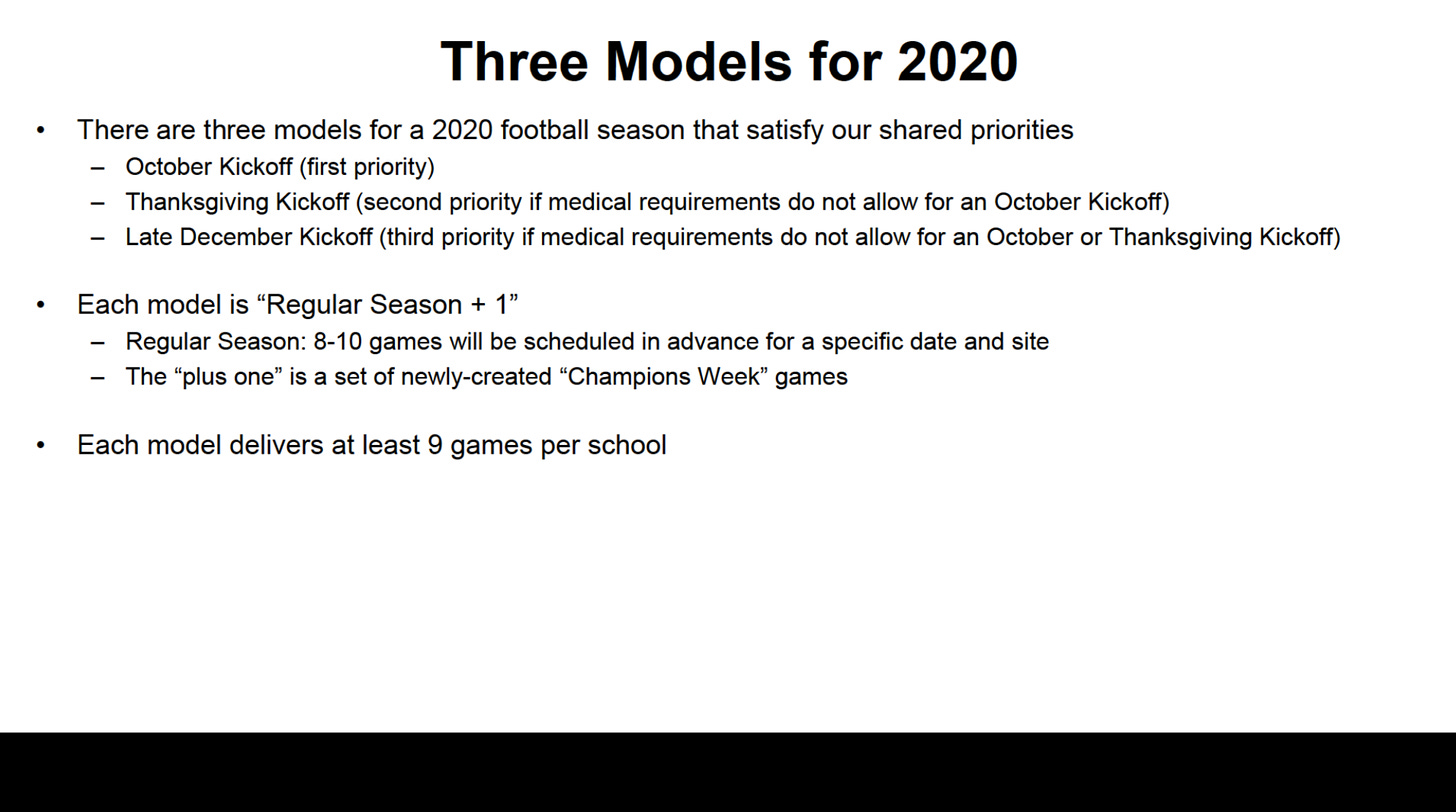
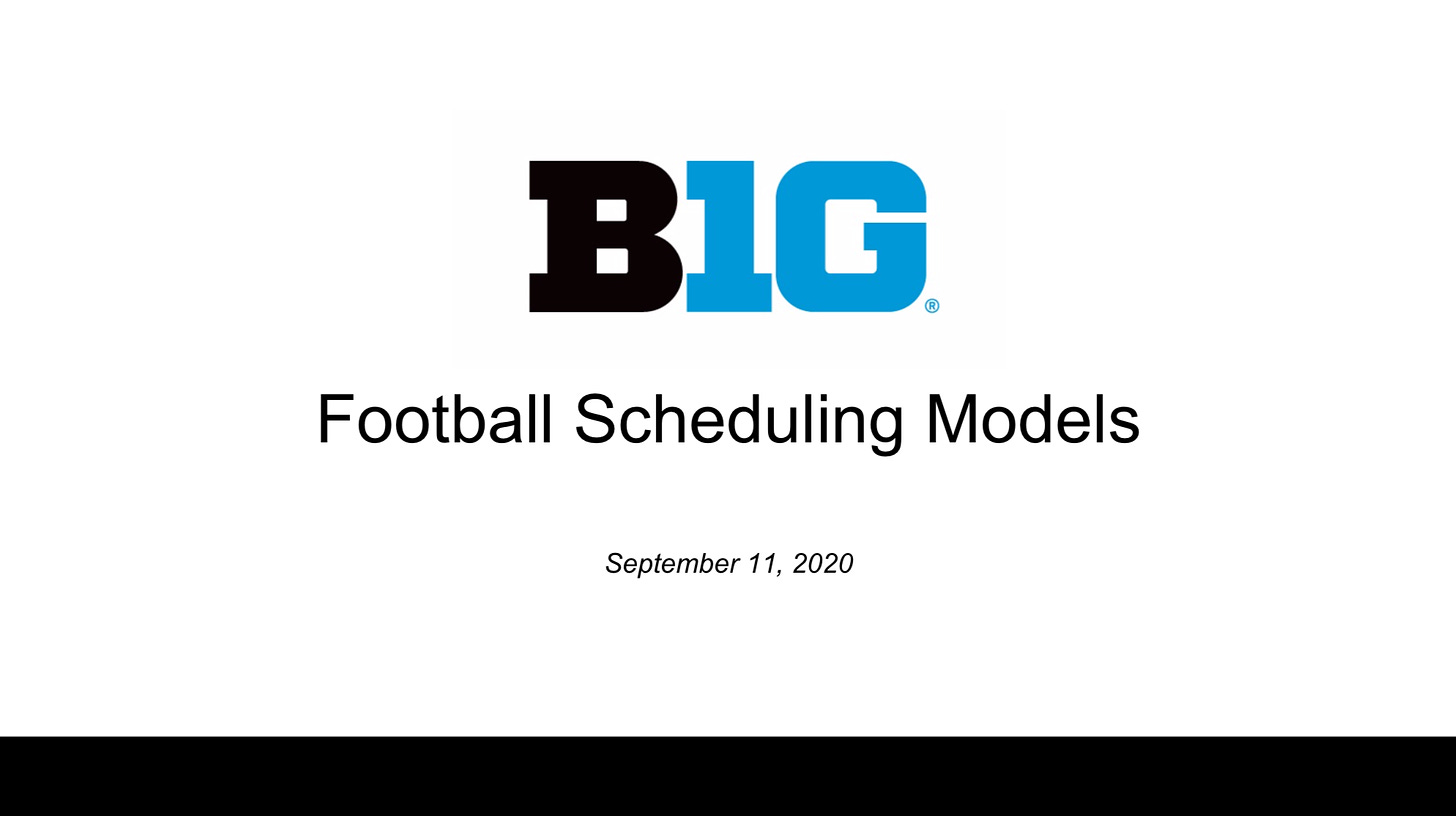
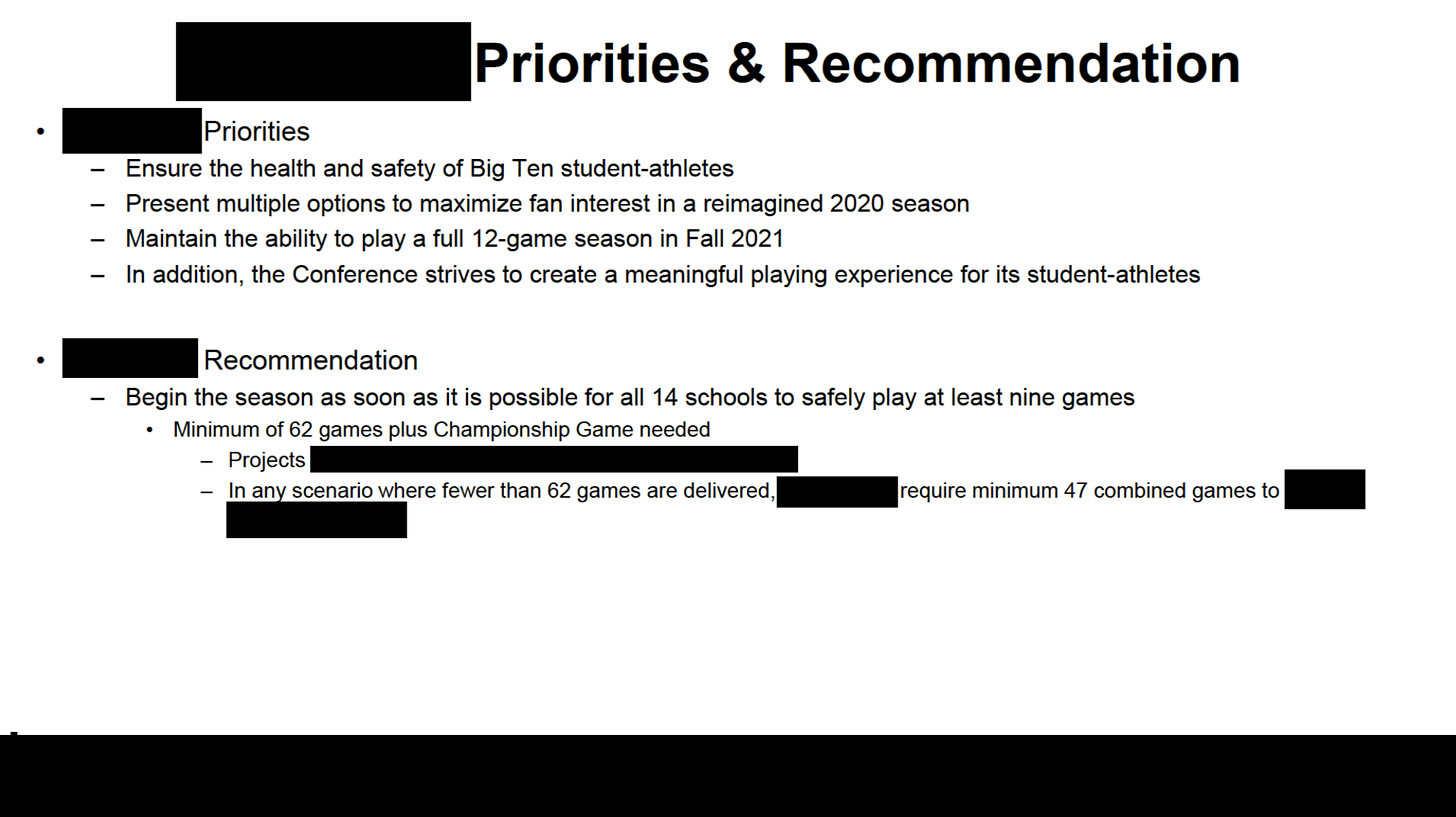
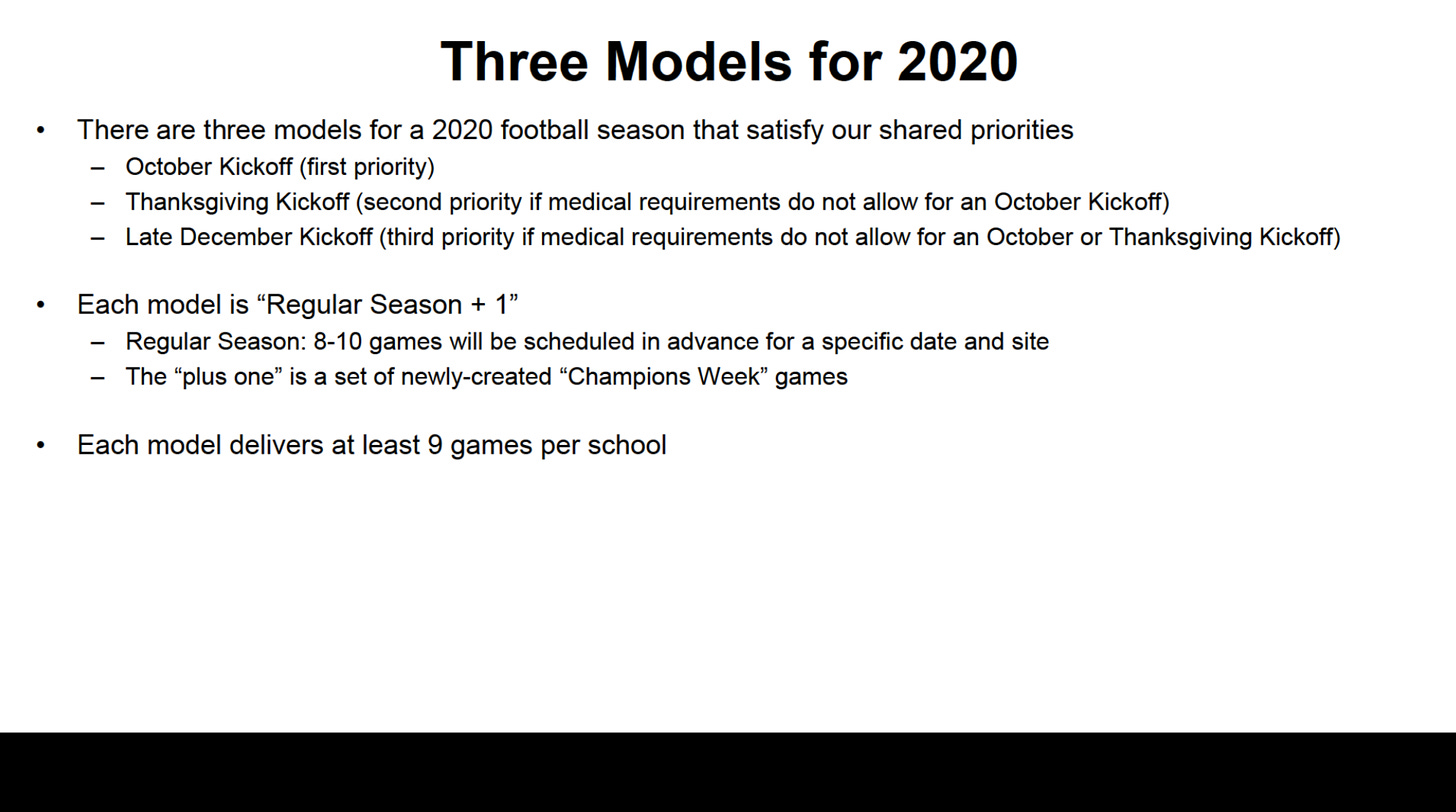







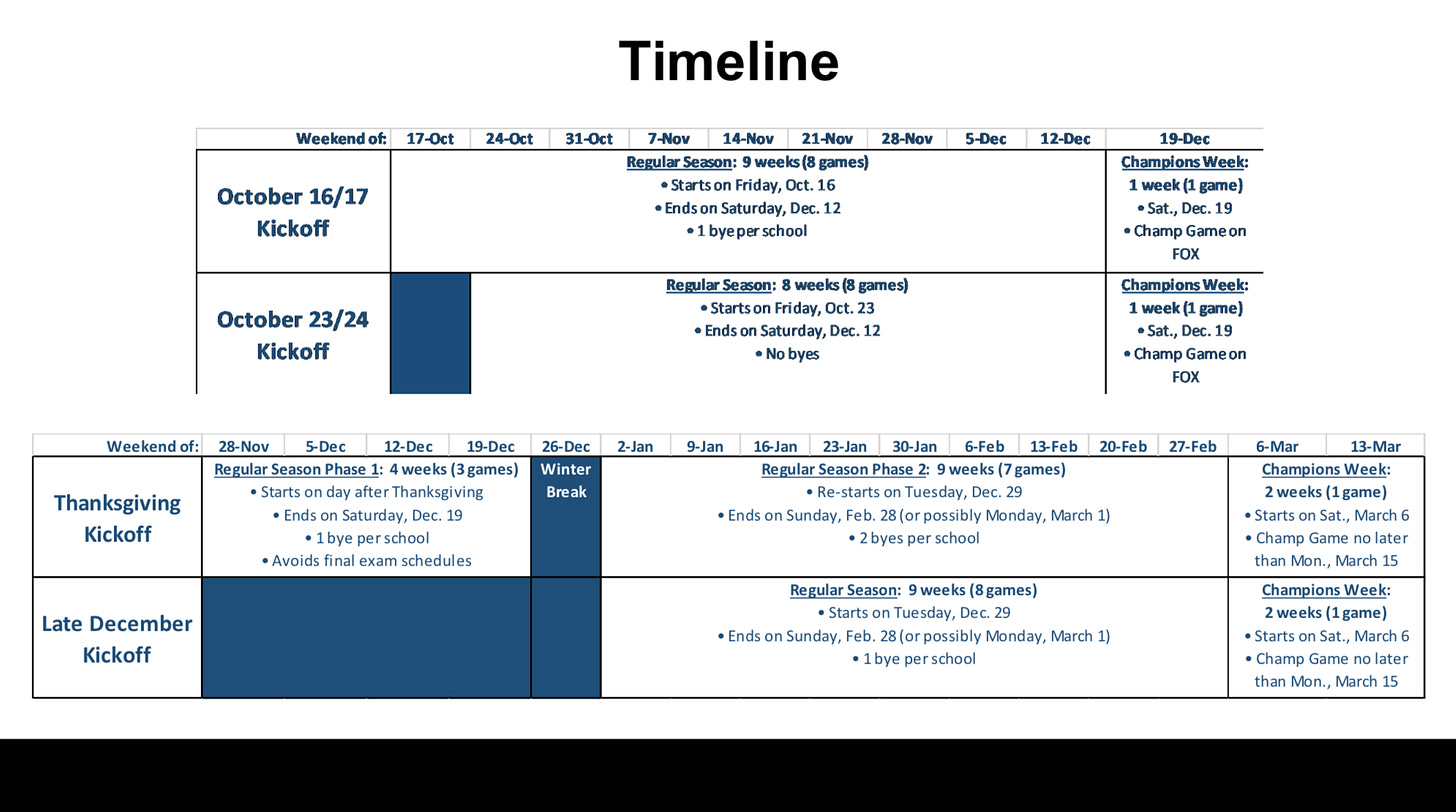



The big ten is an embarrassment. Educators in general have a larger proportion of inept individuals than any profession save government. The fact they didn’t follow science or logic isn’t hard to understand. Why we allow them to be in charge is what’s disconcerting.